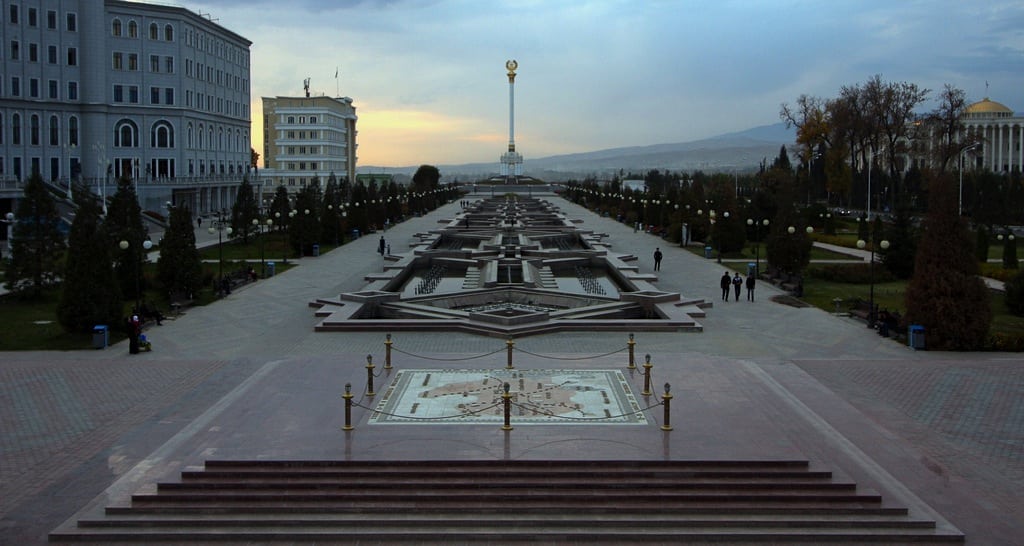Skift Take
Tajikistan was once a global crossroads instead of a regional backwater. It should try both patience and avoiding the over-the-top behavior that has defined its regional neighbors in recent years.
“I like this atmosphere,” said Muzafar, a 20-something volunteer at the American Corner, an outreach program of the U.S. Embassy, as we walked along a boulevard in the Tajikistan capital city of Dushanbe. “I just remember the civil war, growing up, and now these days!”
It was Nowruz, the Persian New Year, celebrated on the first day of spring, and all of Dushanbe’s more than 1 million residents seemed to be out on the streets in a display of the smash-cut of folksy-traditional and trendy-metro that is its bipolar mood this decade.
Just as I was warming to mothers and daughters in brightly patterned village dresses and embroidered pillbox hats selling tandoor flatbread sprinkled with cardamom, I’d spy women sporting tiger-print wraps and black high heels on shopping sprees.
As I lingered to watch teenage boys performing somersaults, I was jostled by others next to loudspeakers blaring Googoosh or Shabnam, Russian and Persian versions of pop. I balked at following this crowd on their way to a packed stadium for an afternoon of the national obsession: gushtingiri (freestyle wrestling).
Yet I’d been feeling this energy not just on Nowruz, but as a low-grade thrumming during my week in Dushanbe and my travels in Tajikistan, if not throughout Central Asia. The trauma of the civil war was a consequence of the meltdown of the former Soviet Union in the 1990s. The bullet holes at the Vakhsh Hotel, a former rebel headquarters, are now covered in thick pink paint.
National identity
My cruising the ’stans over the past year had shown me how each of these former Soviet republics has struggled to segue into its new national identity. Ashgabat, the capital of Turkmenistan, is a freaky monument of conspicuous consumption, with scores of white Carrera marble buildings but few residents; a rarified ghost town.
Kazakhstan blurs in the imagination with Sacha Baron Cohen’s Borat. Visas to Uzbekistan are hard to obtain but well worth the effort for its grand ancient cities of Samarkand and Bukhara.
Yet Tajikistan has been uniquely successful in its transition and has found an enviable equipoise — with hijab optional for women — akin to Turkey’s. A stroll along Dushanbe’s tree-lined main boulevard, Rudaki Avenue, feels like a lovely promenade in more cosmopolitan Prague or Vienna.
Easter eggs
Soviet neoclassical architecture lends an orderliness to the cityscape, with many buildings resembling Easter eggs dipped in pastel dyes: the lemon-yellow Firdousi Library; the baby-blue Russian academy; the Pompeiian-red National Bank; the beige Presidential Palace complex with its splashing fountains.
The Writers Union reflects a more 1920s revolutionary- modern mode, its Bauhaus curves fronted by busts of regional culture heroes, like Persian polymath Omar Khayyam.
Central to Tajik society are its choikhonas, or teahouses, and the grand example is Choikhona Rohat on Rudaki. Its two- story, neon-lit glass front is reminiscent of the old TWA terminal at John F. Kennedy International Airport, while the ceiling of its terrace is painted in an ornate Persian floral style.
It’s a popular venue for regional staples: lagman (lamb and noodle soup) with a salad of parsley, tomato and onion; shashlik kebab; or the ubiquitous plov (a one-pot meat-and-rice stew). The menus are still printed in Cyrillic, the national alphabet, and top picks are borscht, goulash and black kleb bread.
The ride up to pine-covered Victory Park, with its outdoor cafes serving local Simsim beer, afforded us panoramic views of the city and the 13,000-foot-high peaks of the Hissar Range, still snowcapped in spring.
Russian Jiguli
I took another short expedition, in a Russian retro Jiguli sports car, a beauty that I was told I could buy for $500 (shipping not included). The jaunt carried me 18 miles west of town to the Hissar Fortress, once a checkpoint along the ancient Silk Road, that was ransacked in turn by Cyrus, Alexander the Great, Genghis Khan, Tamburlaine, and the Red Army.
Tajikistan was at the nexus of the 19th-century geopolitical “Great Game,” and so its capital remains. Sitting across from us later that Nowruz afternoon, in a blue-striped tented cafe kitty-corner to the grand neoclassical Ayni Opera and Ballet Theatre, a tableful of Saudis wearing red-and-white checked keffiyah scarves drank mint tea (always poured three times into the cup before serving). At the next table a Tajik guy and girl were making out, the boy’s T-shirt emblazoned on the back with the letters “F.B.I.”
Linoleum floors
The U.S. contribution to this Great Game, Dushanbe-style, often comes down to such “cultural exchanges,” though the code is occasionally lost in translation. Our last stop was the Morning Star Cafe, the only faux-American diner in town, complete with wood paneling, checkered linoleum floors, wrought- iron chairs, and a magazine rack with back issues of Time magazine.
Specialties on the big glossy menu included sweetened iced tea, pancakes and biscuits, and chocolate milkshakes. I even overheard two men speaking with a Texas twang, the only two Americans I’d encountered during my 10 days in the country.
But the reminder that we weren’t in Austin anymore was right there on the big chalkboard promising “New Stolrbuck Coffee.” Meanwhile, intending to pay a compliment, Muzafar leaned over his Nescafe and confided in me, “I wish most to be in the U.S. on Black Friday.”
Muse highlights include Jason Harper on cars, Rich Jaroslovsky on technology.
Editors: Frederik Balfour, Jeffrey Burke. To contact the writer of this column: Brad Gooch at [email protected]. To contact the editor responsible for this story: Manuela Hoelterhoff at [email protected]. ![]()
The Daily Newsletter
Our daily coverage of the global travel industry. Written by editors and analysts from across Skift’s brands.
Have a confidential tip for Skift? Get in touch
Tags: tajikistan
Photo credit: Central Dushanbe in Tajikistan. Chris Price / Flickr
